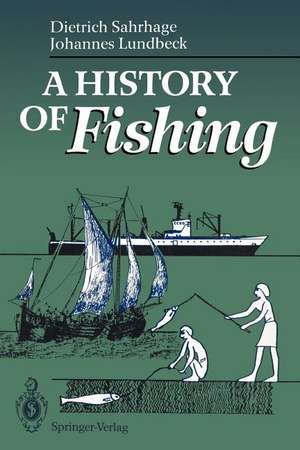A History of Fishing
Autor Dietrich Sahrhage, Johannes Lundbecken Limba Engleză Paperback – 16 dec 2011
Preț: 887.66 lei
Preț vechi: 1082.51 lei
-18% Nou
Puncte Express: 1331
Preț estimativ în valută:
169.85€ • 185.08$ • 143.13£
169.85€ • 185.08$ • 143.13£
Carte tipărită la comandă
Livrare economică 23 aprilie-07 mai
Preluare comenzi: 021 569.72.76
Specificații
ISBN-13: 9783642774133
ISBN-10: 364277413X
Pagini: 360
Ilustrații: VIII, 348 p.
Dimensiuni: 155 x 235 x 19 mm
Greutate: 0.5 kg
Ediția:Softcover reprint of the original 1st ed. 1992
Editura: Springer Berlin, Heidelberg
Colecția Springer
Locul publicării:Berlin, Heidelberg, Germany
ISBN-10: 364277413X
Pagini: 360
Ilustrații: VIII, 348 p.
Dimensiuni: 155 x 235 x 19 mm
Greutate: 0.5 kg
Ediția:Softcover reprint of the original 1st ed. 1992
Editura: Springer Berlin, Heidelberg
Colecția Springer
Locul publicării:Berlin, Heidelberg, Germany
Public țintă
ResearchDescriere
Described here are the origin and general trends in the development of fishing from the earliest times up to the present in various parts of the world. The techniques applied and the economic and social problems involved are covered. Fishing methods have not changed much since the Stone Age, but continuous technical improvements like the construction of sea-worthy ships, more efficient gear, and finally mechanization of fishing have led to enormous development and a high fish production, of now 100 million tons per year. Extensive utilization has caused heavy overexploitation of the resources and consequently growing concern. The book concludes with an evaluation of perspectives for the future utilization of living resources.
Cuprins
1 Early Times.- 1.1 Stone, Bronze and Iron Ages.- 1.1.1 Europe.- 1.1.2 Africa.- 1.1.3 America.- 1.1.4 Asia.- 1.2 Mesopotamia and Egypt.- 1.3 Mediterranean Cultures.- 2 Main Fisheries in Europe since the Middle Ages.- 2.1 Mass Migration and the Vikings.- 2.2 Freshwaters and Fish Ponds.- 2.3 Herring Drift Net Fisheries.- 2.4 Old-Time Cod Fisheries.- 3 Mechanization of Fishing.- 3.1 Trawling: From Sailing Ships to Steamers.- 3.2 Motorization.- 3.3 Further Advances in Fisheries Technology.- 4 Hunting of Marine Mammals.- 4.1 Whaling.- 4.1.1 Northern Waters.- 4.1.2 Sperm Whaling in the “Southern Seas”.- 4.1.3 Mechanization of Whaling.- 4.1.4 Antarctic Waters.- 4.1.5 Regulation of Whaling.- 4.2 Sealing.- 4.2.1 Northern Hemisphere.- 4.2.2 Southern Hemisphere.- 4.2.3 Sirenians and Sea Otters.- 4.2.4 Conflicts with Fisheries.- 5 Development of Modern Fisheries.- 5.1 Statistical Account of World Fishing.- 5.2 Overview on Major Fisheries.- 5.2.1 Japan.- 5.2.2 Russia — Soviet Union.- 5.2.3 China.- 5.2.4 North America.- 5.2.5 Peru and Chile.- 5.2.6 South and Southwest Africa (Namibia).- 5.2.7 Europe.- 5.3 International Law of the Sea.- 6 Fisheries Science.- 7 Perspectives for the Future.














